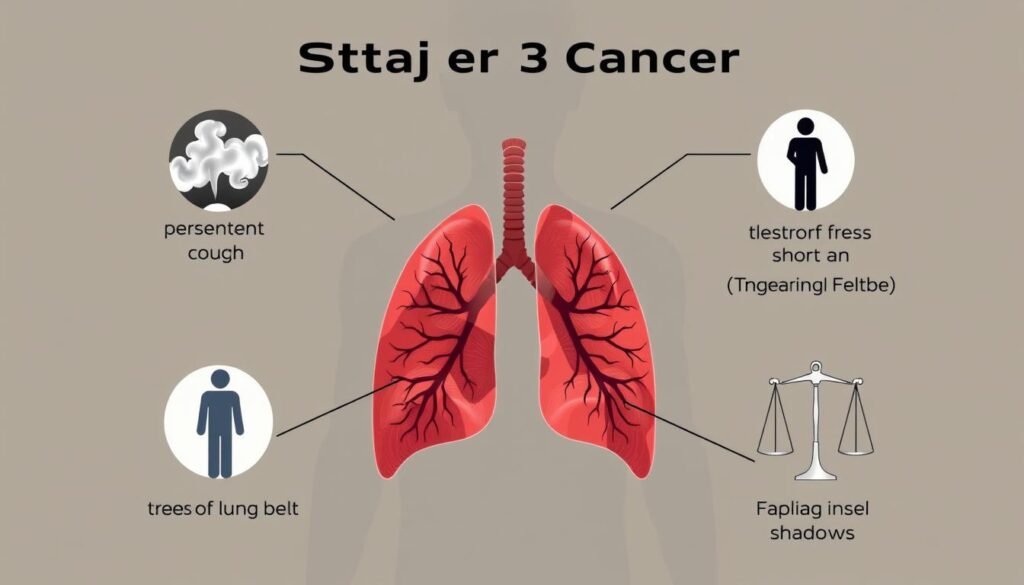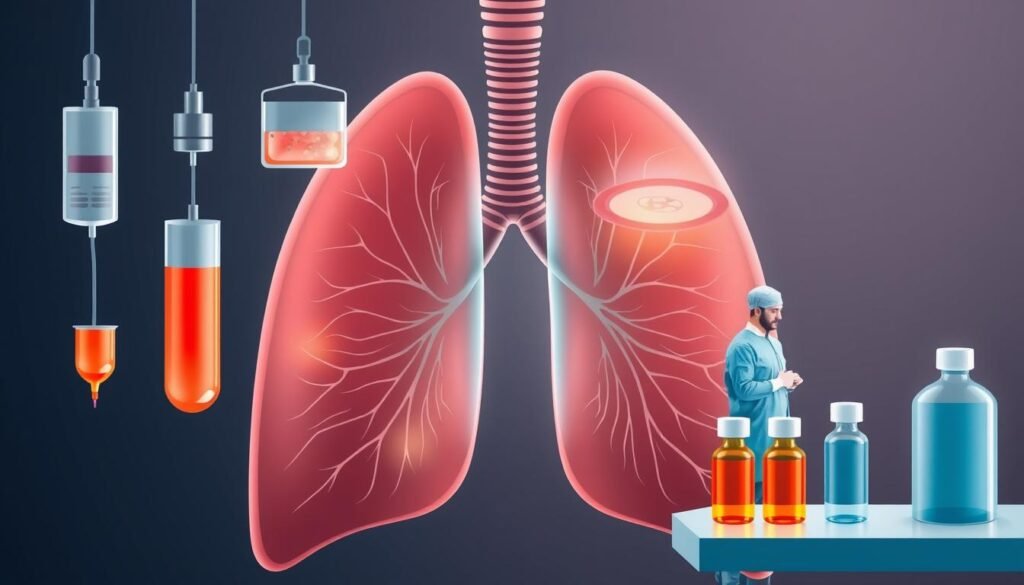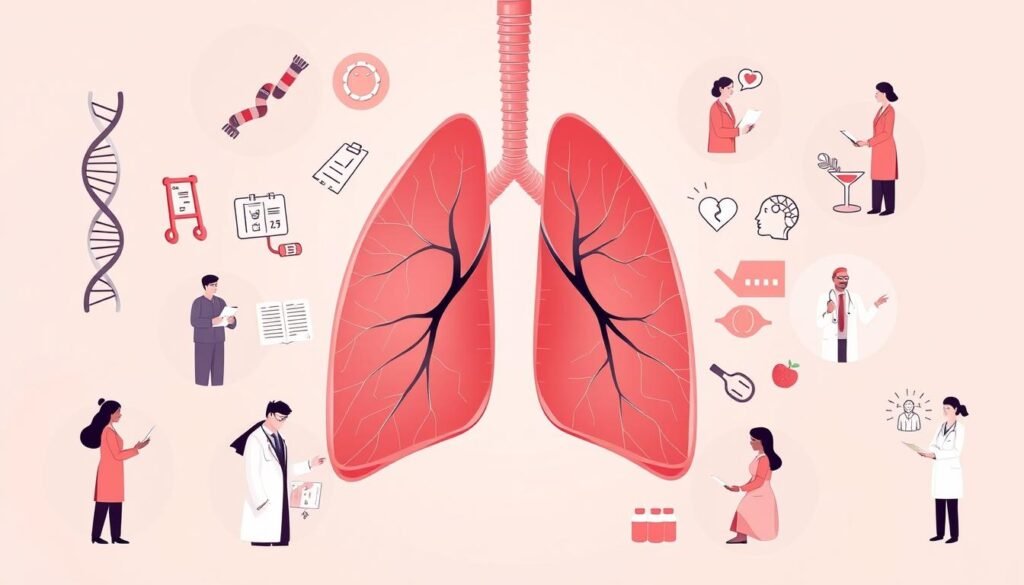Did you know about one-third of lung cancer cases are found at stage 3? This is when the cancer has moved beyond the lungs. Such a fact highlights the seriousness of stage 3 adenocarcinoma lung cancer. This stage marks a turning point in the disease’s progress. Knowing how complex this stage is matters a lot. It affects treatment choices and the possible outcomes for patients.
Stage 3 adenocarcinoma lung cancer is a part of the non-small cell lung cancer (NSCLC) group. This type is most of lung cancers, about 85%. Its outlook is more hopeful than that of small cell lung cancer (SCLC). At this critical stage, finding the right treatments is key. Understanding each substage, 3A, 3B, and 3C, is essential. It helps doctors come up with better treatment plans. This can lead to better survival chances for patients.
Key Takeaways
- About one-third of lung cancer cases are diagnosed at stage 3, indicating significant disease progression.
- Stage 3 adenocarcinoma is a crucial phase that heavily influences prognosis and treatment strategies.
- Non-small cell lung cancer makes up approximately 85% of lung cancer cases, with better survival rates compared to small cell lung cancer.
- Effective treatment options include a combination of chemotherapy, surgery, and targeted therapies.
- Understanding specific stage characteristics enhances the ability to tailor treatment plans for patients.
What is Stage 3 Lung Cancer?
Stage 3 lung cancer means the disease has spread more. It moves beyond the lungs, attacking nearby lymph nodes or tissues. Doctors use the lung cancer stages to figure out the cancer’s spread. This helps them pick the best treatment.
This stage has three parts: 3A, 3B, and 3C. Each shows different cancer behavior and affects treatment plans. It’s key for patients and their families to understand these details.
About 35% find out they have lung cancer at this late stage. Survival rates change with each sub-stage. Stage 3A patients have a 36% chance of surviving five years. For stages 3B and 3C, the chances drop to 26% and 13%.
Types of Stage 3 Lung Cancer
Learning about stage 3 lung cancer is important for caregiving and planning treatment. This stage is divided into non-small cell lung cancer (NSCLC) and small cell lung cancer (SCLC). Both categories affect treatment differently.
NSCLC is more common, making up about 80–85% of all lung cancer cases. Stage 3 NSCLC includes subtypes 3A, 3B, and 3C. Factors like tumor size and spread to lymph nodes decide these subtypes. Stage 3A NSCLC patients might be candidates for surgery. Those with stage 3B or 3C often need chemotherapy, targeted drugs, and maybe radiation.
SCLC accounts for 10–15% of lung cancer cases. It’s split into limited and extensive stages. Limited-stage means cancer is in one chest area. Extensive-stage SCLC has spread more. Surgery might be an option for limited-stage SCLC with a single tumor. It’s key to understand how these types change treatment options.
For detailed data on non-small cell lung cancer stages, visit the American Cancer staging guide.
Understanding Stage 3 Adenocarcinoma Lung Cancer
Stage 3 adenocarcinoma lung cancer is a crucial step in the disease’s progression. It’s divided into sub-stages: 3A, 3B, and 3C. Each one has specific traits about tumor size, lymph node spread, and overall disease reach. These details are key for planning the right treatment. They help patients and doctors make informed choices together.
Characteristics of Stage 3A
Stage 3A’s main features are tumors between 3 cm and 7 cm wide. At this point, the cancer might have spread to local lymph nodes near important areas like the windpipe. Yet, it hasn’t moved to distant organs, keeping some treatment options open.
Characteristics of Stage 3B
In stage 3B, the tumors may be up to 5 cm. They’ve reached lymph nodes across the chest or in the neck area. Also, stage 3B may affect key structures like the chest wall. These factors make treating the disease more complex.
Characteristics of Stage 3C
Stage 3C indicates a harsher spread of the disease. Here, tumors are larger than 5 cm and have hit lymph nodes on both chest sides. This stage calls for a detailed look at the patient’s condition to figure out the best treatment path. Dealing with many affected areas needs a special plan.
| Stage | Size of Tumor | Lymph Node Involvement | Metastasis |
|---|---|---|---|
| Stage 3A | 3 cm to 7 cm | Local lymph nodes (near windpipe, carina, chest wall) | No distant metastasis |
| Stage 3B | Up to 5 cm | Opposite chest lymph nodes, neck, collarbone | No distant metastasis |
| Stage 3C | Greater than 5 cm | Lymph nodes on both sides of the chest | No distant metastasis but significant spread |
Symptoms of Stage 3 Lung Cancer
It’s vital to know the symptoms of stage 3 lung cancer for early treatment. People may notice changes that impact their life. Knowing these signs helps in getting the right medical help quickly.
Common Symptoms
People with stage 3 lung cancer might see:
- Persistent cough that doesn’t get better
- Chest pain that gets worse when you breathe deeply or cough
- Wheezing and trouble breathing
- Unintentional weight loss in a short time
- Hoarseness or voice changes
- Shortness of breath with little activity
These symptoms can lower a patient’s life quality, making it key to watch for any changes and talk to doctors.
Symptoms of Metastasis
As lung cancer grows, and metastasis happens, symptoms worsen. This includes:
- Bone pain distant from the original tumor
- Headaches, which might suggest the brain is involved
- Neurological deficits like weakness or numbness
- Seizures in severe cases
- Jaundice, showing liver involvement
Knowing about metastasis symptoms is crucial. It enables better treatment plans. Prompt action allows for more effective management.

TNM Staging System Explained
The TNM staging system is key for lung cancer understanding. It looks at tumor size, lymph nodes, and metastasis. Knowing this helps stage lung cancer, especially adenocarcinoma, accurately.
Tumor Size (T): The T stage checks the tumor’s size and if it’s spread to nearby areas. It goes from T0, no tumor, to T4, which means the tumor is big or has spread.
- T1: Tumors up to 3 cm, divided as follows:
- T1a: up to 1 cm
- T1b: 1-2 cm
- T1c: 2-3 cm
- T2: Tumors 3-5 cm, or they affect local structures.
- T3: Tumors over 5 cm, or multiple in one lobe, or invading close areas.
- T4: A tumor spreading to nearby important structures like the heart or big vessels.
Lymph Node Involvement (N): This part checks if cancer hit the lymph nodes. It goes from N0, no cancer in nodes, to N3, cancer in far nodes.
- N0: No lymph node cancer.
- N1: Cancer in close lung lymph nodes.
- N2: Cancer in chest center lymph nodes.
- N3: Cancer in distant lymph nodes.
Metastasis (M): This checks if cancer has reached distant parts of the body. M0 means no spread. M1 shows it’s in other organs, with further details on where.
| Classification | Details |
|---|---|
| T (Tumor) | From T0 to T4, based on size and spread. |
| N (Node) | From N0 to N3, showing lymph node involvement. |
| M (Metastasis) | No metastasis as M0, M1 for spread to distant organs. |
The TNM system is vital for lung cancer care. It guides doctors on treatment choices for patients. This way, they can plan better care for stage 3 adenocarcinoma lung cancer with tumor lymph node metastasis.
Lung Cancer Treatment Options
People with stage 3 lung cancer have many possible treatments. The choice depends on the cancer type, size, and patient health. A team of doctors works together to find the best plan. They often use different treatments together for the best results.
Surgical Procedures for Lung Cancer
Surgery can be crucial in treating lung cancer, especially if the tumor can be removed. Surgery options include:
- Lobectomy — removing a lung lobe.
- Pneumonectomy — taking out an entire lung.
- Chest wall resection — cutting out part of the chest wall if cancer spreads there.
Before surgery, neoadjuvant therapies may be used to improve outcomes.
Chemotherapy for Lung Cancer
Chemotherapy is a key part of lung cancer care. It’s often combined with other treatments. Common chemo drug pairs include:
| Chemotherapy Combination | Common Use |
|---|---|
| Cisplatin + Etoposide | Stage III non-small cell lung cancer with chemoradiation |
| Cisplatin + Vinorelbine | Various lung cancer stages |
| Cisplatin + Gemcitabine | Stage III or IV, in certain cases |
Radiation Therapy for Lung Cancer
Radiation therapy aims at leftover cancer cells, prepares for surgery, or acts as the main treatment. When paired with chemotherapy, it works even better. This is mostly for stage IIIA and IIIB lung cancer.
Targeted Therapy and Immunotherapy
New treatments like targeted therapy and immunotherapy are changing lung cancer care. They focus on genetic changes or boosting the immune system. Key drugs include:
- Targeted Therapy: Erlotinib, crizotinib, and sotorasib, based on genetic tests.
- Immunotherapy: Drugs like durvalumab and cemiplimab bring new hope for longer life.
These new treatments offer more tailored and powerful ways to fight lung cancer.

Palliative Care for Lung Cancer Patients
Palliative care is key for those with stage 3 lung cancer. It focuses on managing lung cancer symptoms and improving quality of life. Care addresses physical, emotional, and psychological health.
Key services in palliative care include:
- Medical management of symptoms such as pain, nausea, and fatigue
- Nutritional support to address weight loss
- Emotional counseling to help cope with anxiety and depression
- Physical therapy to maintain mobility and strength
A team of doctors, nurses, and social workers make up the palliative care specialists. They work together with the primary healthcare team. They aim to create a comprehensive care plan tailored to individual needs. Palliative care for lung cancer discussions start early. This helps patients find the best support options for their journey.
Key interventions include oxygen therapy and pain management. Procedures to clear airway blockages are also critical. These efforts ease symptoms and offer patients dignity in their fight against cancer.
People with stage 3 lung cancer face many symptoms requiring strong support. Discussing managing lung cancer symptoms helps patients make wise decisions about their care. This can significantly improve their life quality.
Clinical Trials for Stage 3 Lung Cancer
Clinical trials for lung cancer are key in finding new treatments for those with stage 3 adenocarcinoma. These studies test lung cancer treatments not yet available in standard care. They offer early access to new drugs and close monitoring by healthcare experts.
The variety of clinical trials includes studies on new and combined therapies. One example is a trial on RELATLIMAB plus NIVOLUMAB with chemotherapy for advanced lung cancer. These stage 3 adenocarcinoma clinical studies may greatly improve how we treat this cancer and help patients live longer, healthier lives.
- A double-blind, randomized trial for evaluating the efficacy of BI 1015550 in patients with progressive fibrosing interstitial lung disease (PF-ILDs).
- Research on ADXS-503 with and without Pembrolizumab to assess safety and tolerability in patients with metastatic non-small cell lung cancer.
- A study comparing Ociperlimab with Tislelizumab against Pembrolizumab for untreated lung cancer patients.
- The AERIFY studies evaluating the efficacy of Itepekimab on COPD exacerbations, relevant for patients with lung cancer history.
Patients should talk with their oncologists about enrolling in clinical trials. These discussions can open up new treatment options and offer extra support for managing stage 3 lung cancer.
| Study Name | Focus Area | Type of Treatment | Current Status |
|---|---|---|---|
| BI 1015550 Trial | Progressive Fibrosing Interstitial Lung Diseases | Experimental medication | Ongoing |
| ADXS-503 Study | Metastatic Non-Small Cell Lung Cancer | Monotherapy/Combination with Pembrolizumab | Ongoing |
| Ociperlimab vs. Pembrolizumab | Untreated Lung Cancer | Comparative treatment | Ongoing |
| AERIFY Studies | COPD in Lung Cancer | Medication efficacy | Ongoing |
Prognosis and Survival Rates for Stage 3 Adenocarcinoma Lung Cancer
The outlook for those with stage 3 adenocarcinoma lung cancer varies. Factors like tumor size, lymph node involvement, and patient health impact outcomes. Survival stats show a 37% five-year rate for regional non-small cell lung cancer (NSCLC).
Looking closer, stage 3a NSCLC sees a 36% survival rate. Stage 3b and 3c differ, showing 26% and 13% rates, respectively. This knowledge helps patients and families decide on treatments.
The average five-year survival rate for stage 3 lung cancer is about 22%. Remember, age, smoking history, and health affect prognosis. For instance, those with a lobectomy often live longer than those with a pneumonectomy.
New treatments like immunotherapy and targeted therapy are changing outcomes. Since 90% of lung cancers are non-small cell types, these survival rates are key in treatment choices.
To learn how allergies might connect to lung cancer, more research is needed. Find more about this at here.
| Stage | 5-Year Survival Rate |
|---|---|
| Stage 3A NSCLC | 36% |
| Stage 3B NSCLC | 26% |
| Stage 3C NSCLC | 13% |
| Overall Regional NSCLC Survival Rate | 37% |
| Overall Survival Rate for All Stages of NSCLC | 28% |
Factors Affecting Treatment Decisions
Many things are crucial in choosing the best treatment for stage 3 adenocarcinoma lung cancer. Knowing these factors can greatly change a patient’s experience and result.
The type of cancer and its stage are key in picking treatment options. Adenocarcinoma, a kind of non-small cell lung cancer, needs specific approaches. Each stage of the cancer changes what treatments might work best.
The patient’s overall health matters a lot for treatments like surgery or chemo. Doctors look at the patient’s health, other health problems, and past treatments. This helps them find the best treatment approach.
What the patient wants is also very important. Some might want treatments that help them live longer. Others might want to focus on keeping a good quality of life. Talking openly with the healthcare team helps match treatments with what the patient wants. This conversation helps create a care plan that meets the patient’s needs based on medical info.
Understanding these things can make lung cancer outcomes better. By looking at both the patient’s condition and what they want, doctors can make personalized treatment plans.

| Factor | Description | Impact on Treatment |
|---|---|---|
| Cancer Type and Stage | Specific classification of lung cancer, e.g., adenocarcinoma, and its progression. | Determines available treatment options and expected prognosis. |
| Overall Health | Patient’s general health, including comorbidities and performance status. | Affects eligibility for aggressive treatments. |
| Patient Preferences | Individual goals surrounding treatment outcomes and quality of life. | Guides decision-making towards personalized care. |
Conclusion
Understanding stage 3 adenocarcinoma lung cancer goes beyond its medical aspects. It requires knowing about both physical and emotional impacts. Patients explore treatments through a team-based plan, improving their care experience. They use surgery, chemotherapy, and targeted therapy to move forward in a way that suits them.
It’s also key to know about lung cancer support resources. Tools like the Bach model and screenings from the European Society of Radiology help. These help patients make smart choices. New treatments are creating hope for better survival rates, especially for advanced non-small-cell lung cancer.
Learning about the symptoms, outlook, and treatment options is empowering. It lets patients play an active part in their health care. With constant support and complete care, facing stage 3 adenocarcinoma lung cancer becomes more manageable.